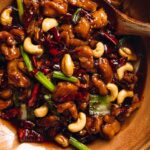The best spring rolls start in your own kitchen! These homemade pork and vegetable spring rolls are a game-changer, with crisp wrappers that shatter delightfully as you bite into them. Stuffed with a savory blend of pork, cabbage, mushrooms, and carrots, they’re a step above any takeout version.
With the option to bake or deep-fry, this recipe is both flexible and foolproof. Serve them hot with a simple sweet and sour dipping sauce, and you’ll be amazed by how easy and satisfying it is to recreate your favorite Chinese restaurant snack at home. Perfect for parties, appetizers, or just treating yourself on a cozy night in.
Full Recipe:
-
1 tbsp oil
-
2 garlic cloves, minced
-
400g (13 oz) pork mince (or ground chicken/turkey)
-
6 dried shiitake mushrooms (or 8 fresh), finely chopped
-
1 ½ cups shredded carrot
-
1 ½ cups bean sprouts
-
1 ½ cups shredded green cabbage
-
1 tsp cornflour
-
1 ½ tbsp oyster sauce
-
2 tsp soy sauce
For Wrapping and Cooking:
-
15–20 spring roll wrappers (21.5 cm / 8” squares), thawed
-
2 tsp cornflour + 1 tbsp water (for sealing)
-
Vegetable oil for deep frying (or oil spray for baking)
Sweet & Sour Sauce (Optional):
-
2 tsp cornflour
-
2 tbsp water
-
½ cup apple cider vinegar
-
1/3 cup brown sugar
-
2 tbsp tomato ketchup
-
2 tsp soy sauce
Directions:
-
Heat oil in a wok or skillet over high heat. Sauté garlic, then add pork and cook until no longer pink.
-
Stir in mushrooms, carrot, bean sprouts, and cabbage. Cook until softened (about 3 minutes).
-
Mix in cornflour, oyster sauce, and soy sauce. Cook for 1 more minute until liquid evaporates. Let the filling cool.
-
Mix sealing slurry (cornflour + water).
-
Peel a spring roll wrapper and lay it diamond-side up. Add a heaped dessert spoon of filling.
-
Roll up halfway, fold in sides, roll up completely, seal with slurry. Repeat.
-
Heat oil in a wok until hot (test with chopstick bubbles). Fry rolls in batches for 1½–2 minutes until golden.
-
Drain on paper towels and serve with Sweet & Sour Sauce.
Optional Baked Version:
Place rolls on a wire rack on a baking sheet. Spray generously with oil. Bake at 200°C (400°F) for 20–25 minutes, no turning needed.
Prep Time: 20 minutes | Cooking Time: 20 minutes | Total Time: 40 minutes
Kcal: 176 kcal (approx.) | Servings: 15–20 rolls
The Allure of Homemade Spring Rolls
Spring rolls are a beloved snack or appetizer found in many Asian cuisines, from Chinese to Vietnamese. The magic of a spring roll lies in its crispy exterior and deliciously savory filling. While spring rolls are commonly served in restaurants, making them at home offers a whole new level of satisfaction. Homemade spring rolls allow you to control the ingredients, ensuring that the filling is fresh and flavorful, and the exterior is perfectly crispy. The beauty of making spring rolls yourself lies in the ability to customize the filling according to your preferences. Whether you prefer a meat-filled roll, like pork or chicken, or want a vegetarian version, the options are endless.
History and Origins of Spring Rolls
Spring rolls have a rich history that dates back to ancient China. They are often associated with Chinese New Year, symbolizing wealth and prosperity. The rolls, traditionally made with thin wheat wrappers, are filled with a variety of ingredients like pork, shrimp, or vegetables. Over time, the dish spread across Asia, with different countries adapting the recipe to fit local tastes and ingredients. In Vietnam, for example, spring rolls are made with rice paper and filled with fresh herbs, shrimp, and vermicelli noodles, known as gỏi cuốn. In China, spring rolls are typically deep-fried, giving them the golden, crispy texture we all know and love.
The cultural significance of spring rolls can’t be overlooked—they symbolize good fortune, renewal, and the joy of coming together to share a meal with family and friends. Over time, spring rolls have evolved into a universally loved dish, available in both traditional and modern forms. Whether served fresh or fried, spring rolls continue to be a popular choice for celebrations and casual gatherings.
The Basics of Making Spring Rolls at Home
Making spring rolls at home is easier than you might think. The essential components of spring rolls include the wrapper, the filling, and the frying method. Spring roll wrappers, typically made from wheat flour, are available at most Asian grocery stores. These thin sheets of dough are surprisingly easy to handle, and they fry up beautifully to create that crisp, golden exterior. While some might opt for rice paper wrappers, wheat-based wrappers provide the classic, crunchy texture that many crave.
When it comes to the filling, there is no one-size-fits-all recipe. The traditional Chinese spring roll filling consists of ground pork, finely chopped vegetables, and sometimes mushrooms. The combination of these ingredients offers a savory, umami-packed flavor that pairs perfectly with the crispy wrapper. In addition to pork, you can use chicken, shrimp, or even tofu for a vegetarian version. The key to a great filling is ensuring that it’s well-seasoned and not too watery, as a soggy filling can lead to a less-than-crispy spring roll.
Different Variations of Spring Rolls
Spring rolls are incredibly versatile, and the filling options are nearly limitless. Here are a few popular variations that will inspire you to get creative in the kitchen:
-
Classic Pork Spring Rolls: The most traditional version, often filled with ground pork, cabbage, carrots, and shiitake mushrooms. The pork adds a rich flavor, while the vegetables balance the texture and freshness.
-
Vegetarian Spring Rolls: For those who prefer plant-based ingredients, vegetarian spring rolls are a delicious and satisfying alternative. Common fillings include shredded cabbage, carrots, bean sprouts, and mushrooms, all seasoned with soy sauce and oyster sauce for depth of flavor.
-
Shrimp Spring Rolls: If you love seafood, shrimp spring rolls are a great option. Shrimp adds a delicate sweetness and firm texture to the filling, making them a lighter alternative to pork-filled rolls.
-
Chicken Spring Rolls: Ground chicken can be used in place of pork for a leaner option. Chicken pairs well with a variety of vegetables, making it a flexible filling choice.
-
Sweet Spring Rolls: For a fun twist on the savory version, sweet spring rolls are a treat. Fill them with ingredients like chocolate, bananas, or apples, and deep-fry for a crispy dessert.
Frying vs. Baking: Which Method is Best?
One of the main decisions when making spring rolls is whether to fry them or bake them. Both methods have their advantages, depending on your preferences and dietary needs.
-
Frying: Traditional spring rolls are deep-fried, resulting in a perfectly crispy and golden exterior. The frying process ensures that the filling stays moist while the wrapper becomes flaky and crisp. Frying also brings out the rich flavors of the filling, as the oil helps to seal in the taste. While frying yields the best texture, it does add extra calories, making it less ideal for those looking to cut down on fat.
-
Baking: For a healthier alternative, baking spring rolls is a great option. When baked, the spring rolls are still crispy but with less oil. Baking involves placing the rolls on a rack and spraying them with a light coat of oil, allowing the heat to crisp them up. While the texture may not be quite as flaky as deep-fried rolls, baked spring rolls are still delicious and much lighter.
Tips for Making Perfect Spring Rolls
While making spring rolls might seem intimidating, a few simple tips can help ensure that your homemade spring rolls turn out perfectly every time.
-
Don’t Overfill the Rolls: When filling your spring rolls, it’s important not to overstuff them. Overfilling can lead to bursting rolls during frying, and no one wants that! A heaping spoonful of filling is usually enough.
-
Seal the Rolls Properly: Sealing your spring rolls properly is essential to prevent them from opening up while frying. Use a mixture of cornstarch and water to create a slurry, which will help seal the edges tightly.
-
Ensure the Filling is Cool: Never use hot filling in your spring rolls. The filling should be at room temperature before wrapping. If the filling is too hot, it can cause the wrapper to tear or become soggy.
-
Test the Oil Temperature: If you’re frying your spring rolls, make sure the oil is hot enough before adding the rolls. To test, dip a chopstick into the oil—if bubbles form around it, the oil is ready. If the oil is too cool, the rolls will absorb too much oil and become greasy.
-
Use a Rack for Baking: When baking spring rolls, place them on a wire rack instead of directly on the baking sheet. This allows air to circulate around the rolls, ensuring an even crispness on all sides.
Why Homemade Spring Rolls Are Better Than Takeout
There’s something truly satisfying about making spring rolls from scratch. Not only do you get to enjoy the freshest ingredients, but you can also tailor the filling to your exact tastes. When you make spring rolls at home, you have control over the seasoning, the choice of meat or vegetables, and the cooking method. This means you can avoid the overly greasy, soggy spring rolls often found in takeout restaurants.
Homemade spring rolls also allow you to experiment with flavors. You can try new ingredients or seasonings that you may not find in a traditional takeout spring roll. For example, adding herbs like cilantro or basil can brighten up the filling and add a fresh kick. Additionally, you can make larger batches and freeze some for later, ensuring you always have a tasty snack on hand.
Conclusion: Enjoy the Perfection of Homemade Spring Rolls
Homemade spring rolls offer a world of possibilities. Whether you prefer them fried or baked, packed with pork, shrimp, or vegetables, spring rolls are a fun and customizable dish to prepare in the comfort of your own kitchen. With a little practice and the right tips, you can easily master the art of making these crispy, golden treats. Serve them as appetizers at your next party, enjoy them as a snack, or even make a meal out of them—there’s no wrong way to enjoy spring rolls.





